seat LOTUS ELISE 2005 Owners Manual
[x] Cancel search | Manufacturer: LOTUS, Model Year: 2005, Model line: ELISE, Model: LOTUS ELISE 2005Pages: 205, PDF Size: 4.51 MB
Page 3 of 205
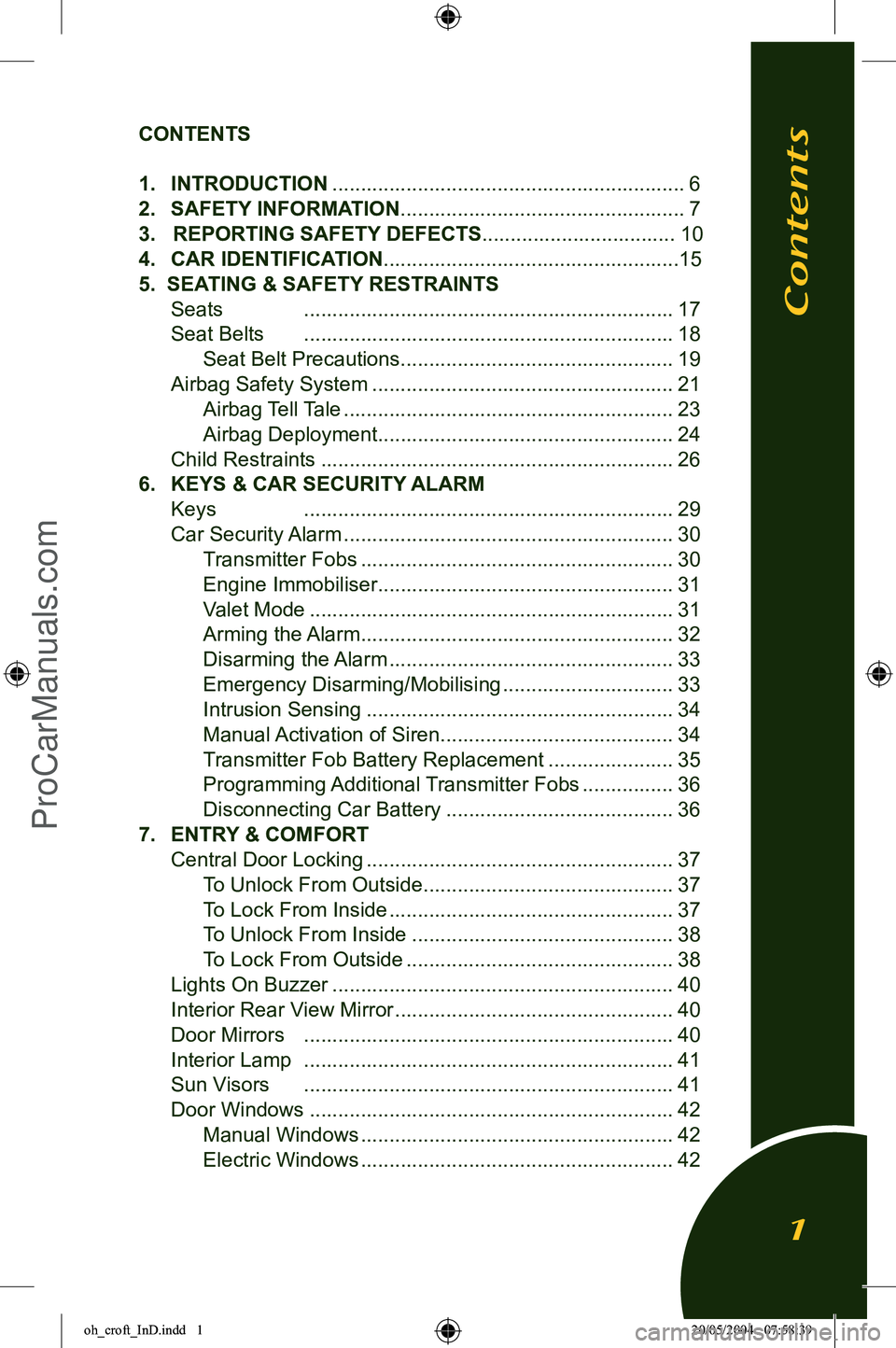
CONTENTS
1. INTRODUCTION ..............................................................
6
2. SAFETY INFORMATION ..................................................7
3. REPORTING SAFETY DEFECTS
.................................. 10
4. CAR IDENTIFICATION
....................................................15
5. SEATING & SAFETY REST
RAINTS
Seats .................................................................
17
Seat Belts .................................................................
18
Seat Belt Precautions ................................................
19
Airbag Safety System .....................................................
21
Airbag Tell Tale ..........................................................
23
Airbag Deployment ....................................................
24
Child Restraints ..............................................................
26
6. KEYS & CAR SECURITY ALARM
Keys .................................................................
29
Car Security Alarm ..........................................................
30
Transmitter Fobs .......................................................
30
Engine Immobiliser ....................................................
31
Valet Mode ................................................................
31
Arming the Alarm .......................................................
32
Disarming the Alarm ..................................................
33
Emergency Disarming/Mobilising ..............................
33
Intrusion Sensing ......................................................
34
Manual Activation of Siren .........................................
34
Transmitter Fob Battery Replacement ......................
35
Programming Additional Transmitter Fobs ................
36
Disconnecting Car Battery ........................................
36
7. ENTRY & COMFORT
Central Door Locking ......................................................
37
To Unlock From Outside ............................................
37
To Lock From Inside ..................................................
37
To Unlock From Inside ..............................................
38
To Lock From Outside ...............................................
38
Lights On Buzzer ............................................................
40
Interior Rear View Mirror .................................................
40
Door Mirrors .................................................................
40
Interior Lamp .................................................................
41
Sun Visors .................................................................
41
Door Windows ................................................................
42
Manual Windows .......................................................
42
Electric Windows .......................................................
42
Contents
1
oh_croft_InD.indd 120/05/2004 07:58:39ProCarManuals.com
Page 4 of 205
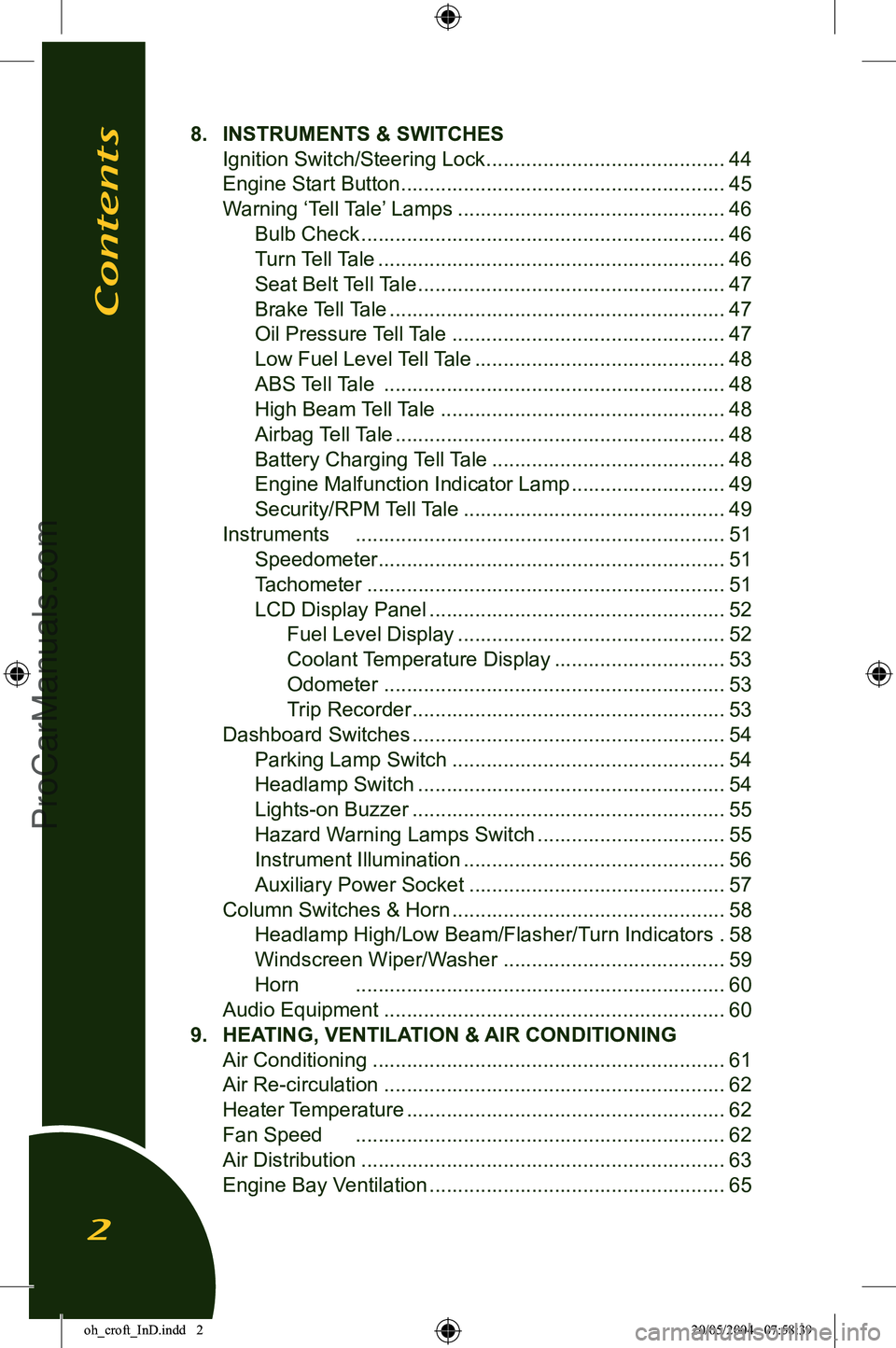
8. INSTRUMENTS & SWITCHES
Ignition Switch/Steering Lock ..........................................
44
Engine Start Button .........................................................
45
Warning āTell Taleā Lamps ...............................................
46
Bulb Check ................................................................
46
Turn Tell Tale .............................................................
46
Seat Belt Tell Tale ......................................................
47
Brake Tell Tale ...........................................................
47
Oil Pressure Tell Tale ................................................
47
Low Fuel Level Tell Tale ............................................
48
ABS Tell Tale ............................................................
48
High Beam Tell Tale ..................................................
48
Airbag Tell Tale ..........................................................
48
Battery Charging Tell Tale .........................................
48
Engine Malfunction Indicator Lamp ...........................
49
Security/RPM Tell Tale ..............................................
49
Instruments .................................................................
51
Speedometer .............................................................
51
Tachometer ...............................................................
51
LCD Display Panel ....................................................
52
Fuel Level Display ...............................................
52
Coolant Temperature Display ..............................
53
Odometer ............................................................
53
Trip Recorder .......................................................
53
Dashboard Switches .......................................................
54
Parking Lamp Switch ................................................
54
Headlamp Switch ......................................................
54
Lights-on Buzzer .......................................................
55
Hazard Warning Lamps Switch .................................
55
Instrument Illumination ..............................................
56
Auxiliary Power Socket .............................................
57
Column Switches & Horn ................................................
58
Headlamp High/Low Beam/Flasher/Turn Indicators .
58
Windscreen Wiper/Washer .......................................
59
Horn .................................................................
60
Audio Equipment ............................................................
60
9. HEATING, VENTILATION & AIR CONDITIONING
Air Conditioning ..............................................................
61
Air Re-circulation ............................................................
62
Heater Temperature ........................................................
62
Fan Speed .................................................................
62
Air Distribution ................................................................
63
Engine Bay Ventilation ....................................................
65
Contents
2
oh_croft_InD.indd 220/05/2004 07:58:39ProCarManuals.com
Page 5 of 205
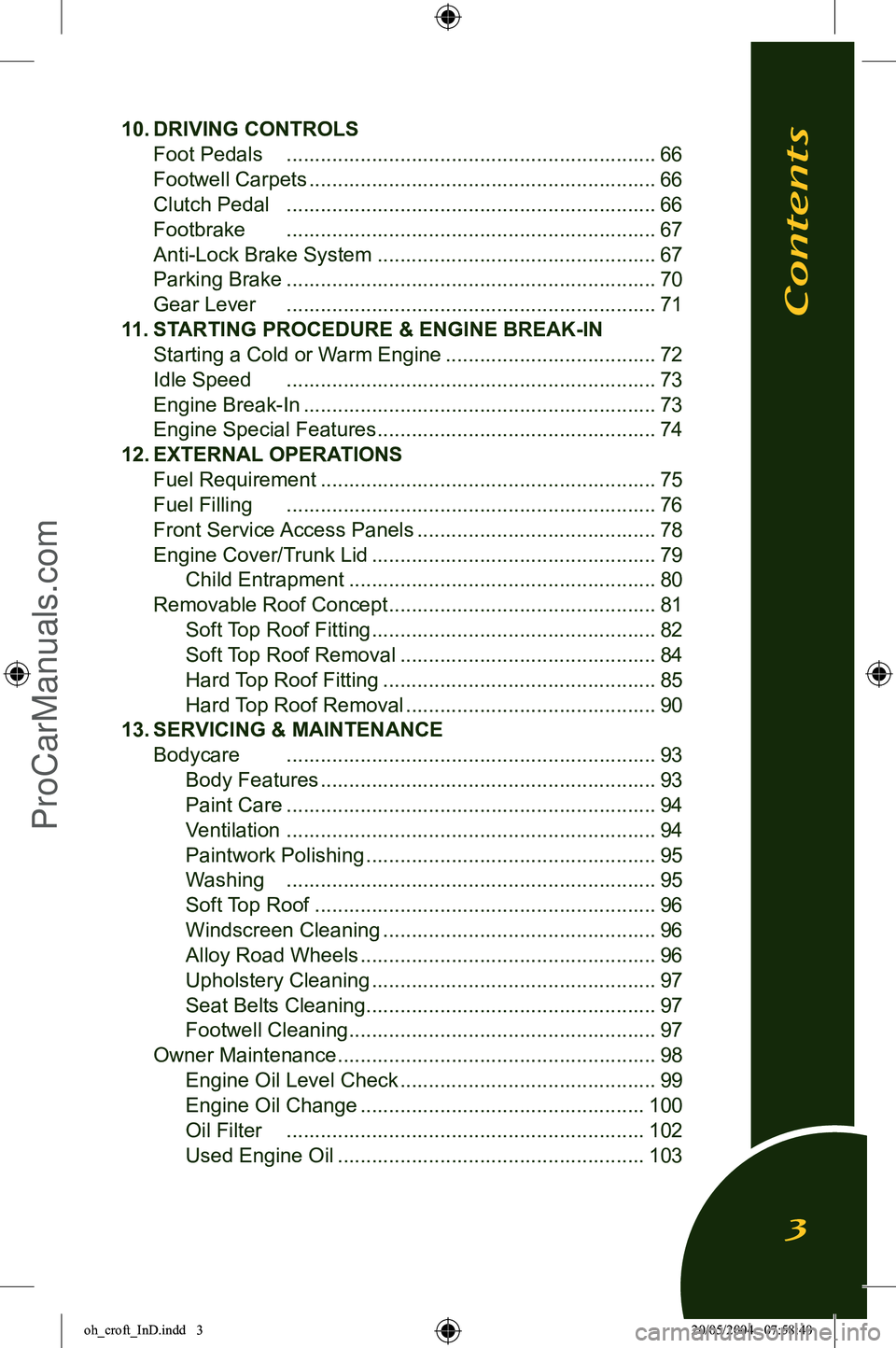
10. DRIVING CONTROLS
Foot Pedals .................................................................
66
Footwell Carpets .............................................................
66
Clutch Pedal .................................................................
66
Footbrake .................................................................
67
Anti-Lock Brake System .................................................
67
Parking Brake .................................................................
70
Gear Lever .................................................................
71
11. STARTING PROCEDURE & ENGINE BREAK-IN
Starting a Cold or Warm Engine .....................................
72
Idle Speed .................................................................
73
Engine Break-In ..............................................................
73
Engine Special Features .................................................
74
12. EXTERNAL OPERATIONS
Fuel Requirement ...........................................................
75
Fuel Filling .................................................................
76
Front Service Access Panels ..........................................
78
Engine Cover/Trunk Lid ..................................................
79
Child Entrapment ......................................................
80
Removable Roof Concept ...............................................
81
Soft Top Roof Fitting ..................................................
82
Soft Top Roof Removal .............................................
84
Hard Top Roof Fitting ................................................
85
Hard Top Roof Removal ............................................
90
13. SERVICING & MAINTENANCE
Bodycare .................................................................
93
B
ody Features ...........................................................93
Paint Care .................................................................
94
Ventilation .................................................................
94
Paintwork Polishing ...................................................
95
Washing .................................................................
95
Soft Top Roof ............................................................
96
Windscreen Cleaning ................................................
96
Alloy Road Wheels ....................................................
96
Upholstery Cleaning ..................................................
97
Seat Belts Cleaning ...................................................
97
Footwell Cleaning ......................................................
97
Owner Maintenance ........................................................
98
Engine Oil Level Check .............................................
99
Engine Oil Change ..................................................
100
Oil Filter ...............................................................
102
Used Engine Oil ......................................................
103
Contents
3
oh_croft_InD.indd 320/05/2004 07:58:40ProCarManuals.com
Page 9 of 205
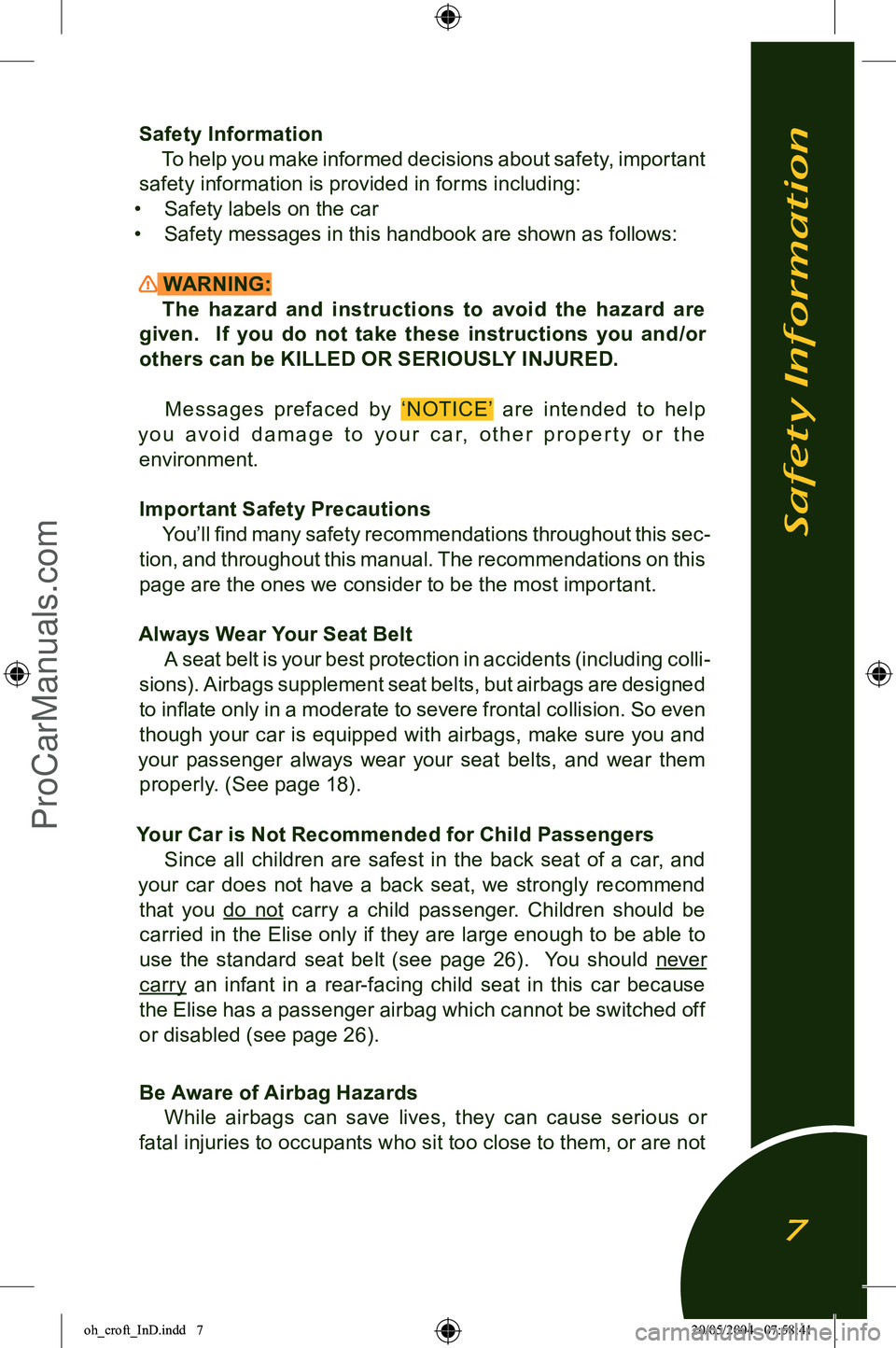
Safety InformationTo help you make informed decisions about safety, important
safety information is provided in forms including:
ā¢ Safety labels on the car
ā¢ Safety messages in this handbook are shown as follows:
WARNING: The hazard and instructions to avoid the hazard are
given. If you do not take these instructions you and /or
others can be KILLED OR SERIOUSLY INJURED.
Messages prefac ed by
āNOTICEā are intended to help
y o u a v o i d d a m a g e t o y o u r c a r, o t h e r p r o p e r t y o r t h e
environment.
Important Safety Precautions Youāll ļ¬nd many safety recommendations throughout this sec
-
tion, and throughout this manual. The recommendations on this page are the ones we consider to be the most important.
Always Wear Your Seat Belt A seat belt is your best protection in accidents (including colli
-
sions). Airbags supplement seat belts, but airbags are designed
to inļ¬ate only in a moderate to severe frontal collision. So even
though your car is equipped with airbags, make sure you and
your passenger always wear your seat belts, and wear them properly. (See page 18).
Your Car is Not Recommended for Child Passengers Since all children are safest in the back seat of a car, and
your car does not have a back seat, we strongly recommend that you do not carry a child passenger. Children should be
carried in the Elise only if they are large enough to be able to
use the standard seat belt (see page 26). You should never
carry an infant in a rear-facing child seat in this car because
the Elise has a passenger airbag which cannot be switched off or disabled (see page 26).
Be Aware of Airbag Hazards While airbags can save lives, they can cause serious or
fatal injuries to occupants who sit too close to them, or are not
Safety Information
7
oh_croft_InD.indd 720/05/2004 07:58:41ProCarManuals.com
Page 10 of 205
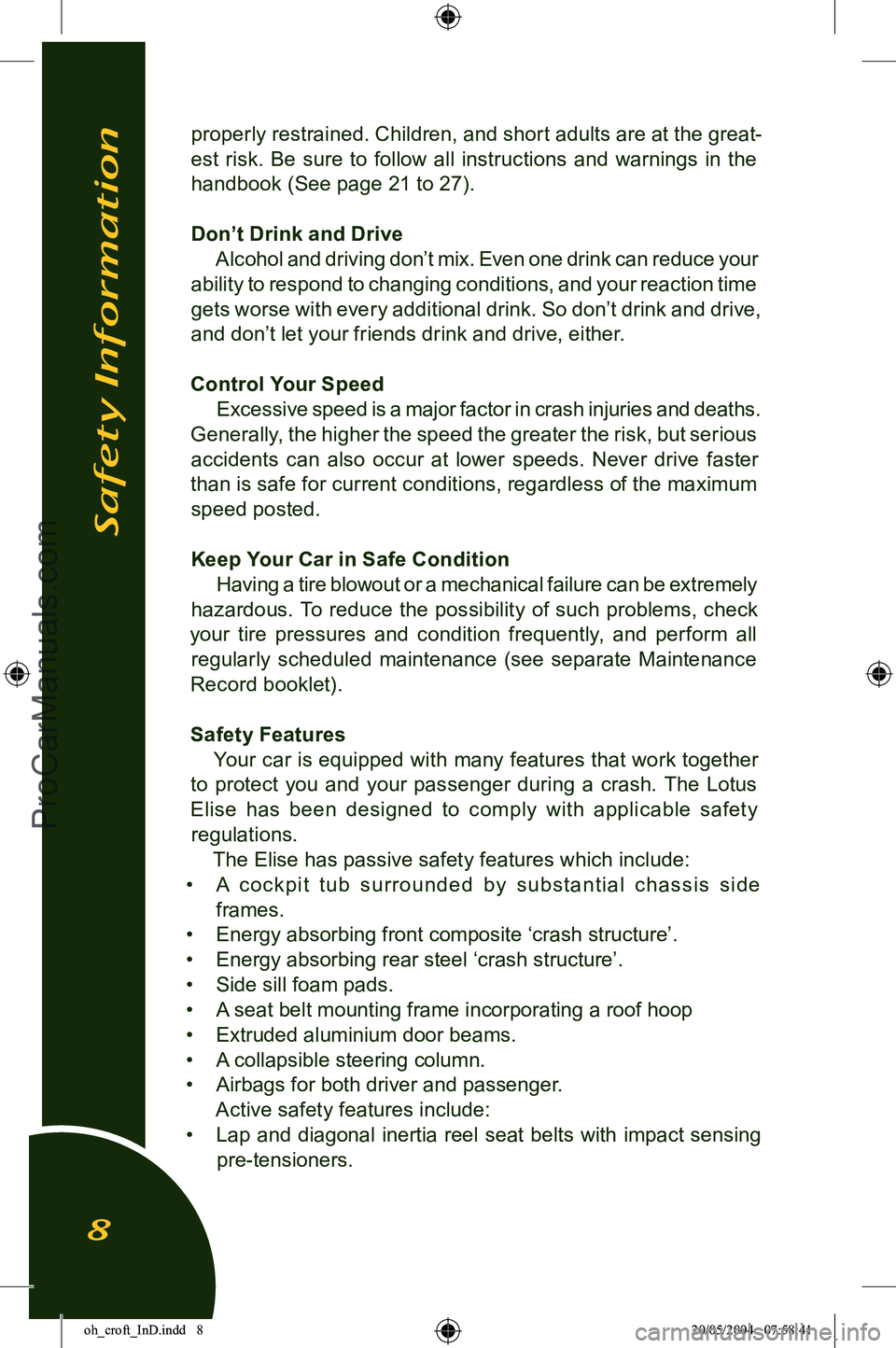
properly restrained. Children, and short adults are at the great-
est risk. Be sure to follow all instructions and warnings in the handbook (See page 21 to 27).
Donāt Drink and Drive Alcohol and driving donāt mix. Even one drink can reduce your
ability to respond to changing conditions, and your reaction time
gets worse with every additional drink. So donāt drink and drive,
and donāt let your friends drink and drive, either.
Control Your Speed Excessive speed is a major factor in crash injuries and deaths.
Generally, the higher the speed the greater the risk, but serious accidents can also occur at lower speeds. Never drive faster
than is safe for current conditions, regardless of the maximum speed posted.
Keep Your Car in Safe Condition Having a tire blowout or a mechanical failure can be extremely
hazardous. To reduce the possibility of such problems, check
your tire pressures and condition frequently, and perform all
regularly scheduled maintenance (see separate Maintenance
Record booklet).
Safety Features Your car is equipped with many features that work together
to protect you and your passenger during a crash. The Lotus Elise has been designed to comply with applicable safety regulations. The Elise has passive safety features which include:
ā¢ A cockpit tub surrounded by substantial chassis side
frames.
ā¢ Energy absorbing front
composite ācrash structureā.
ā¢ Energy absorbing rear steel
ācrash structureā.
ā¢ Side sill foam pads.
ā¢ A seat belt mounting frame incorporating a roof hoop
ā¢ Extruded aluminium door beams.
ā¢ A collapsible steering column.
ā¢ Airbags for both driver and passenger. Active safety features include:
ā¢ Lap and diagonal inertia reel seat belts with impact sensing
pre-tensioners.
Safety Information
8
oh_croft_InD.indd 820/05/2004 07:58:41ProCarManuals.com
Page 11 of 205

ā¢ Powerful anti-lock four wheel disc brakes.
ā¢ High geared responsive steering requiring only small steering
wheel movements to alter course
ā¢ Exceptional road holding with optimised handling character
-
istics
You and your passenger cannot take full advantage of these
safety features unless you remain sitting in a proper position
and always wear your seat belt properly. In fact, some safety
features can contribute to injuries if they are not used properly. Drivers should be aware of their own limitations as well as
those of the car, and ensure that all road driving is conducted
well within both sets of capabilities, particularly on wet roads, or under adverse weather conditions.
Remember:
Driving a car requires:
ā¢ Care;
ā¢ Attention; and
ā¢ Sensible judgement.
Be aware that any motor car has the potential to cause death
or injury both to its occupants and/or other persons, and must
be used only in a responsible and cautious manner. This entire
handbook is ļ¬lled with important safety information.
Please
read it carefully.
Remember:
ā¢ ALWAYS WEAR YOUR SEAT BELT.
ā¢ Never drive while under the inļ¬uence of alcohol or drugs.
ā¢ Never drive when excessively tired.
ā¢ Never use mobile phones, map read or attempt other distract
-
ing activities whilst driving.
ā¢ Always obey all speed and trafļ¬c laws and regulations and never drive faster than the posted speed limit or than condi
-
tions allow.
ā¢ Be particularly careful driving on slippery or wet surfaces.
ā¢ Familiarise yourself with the car and always drive prudently, being aware of your own limitations and the limitations of the
car. Failure to operate the car properly can result in an ac
-
cident and serious injury.
Safety Information
9
oh_croft_InD.indd 920/05/2004 07:58:41ProCarManuals.com
Page 16 of 205
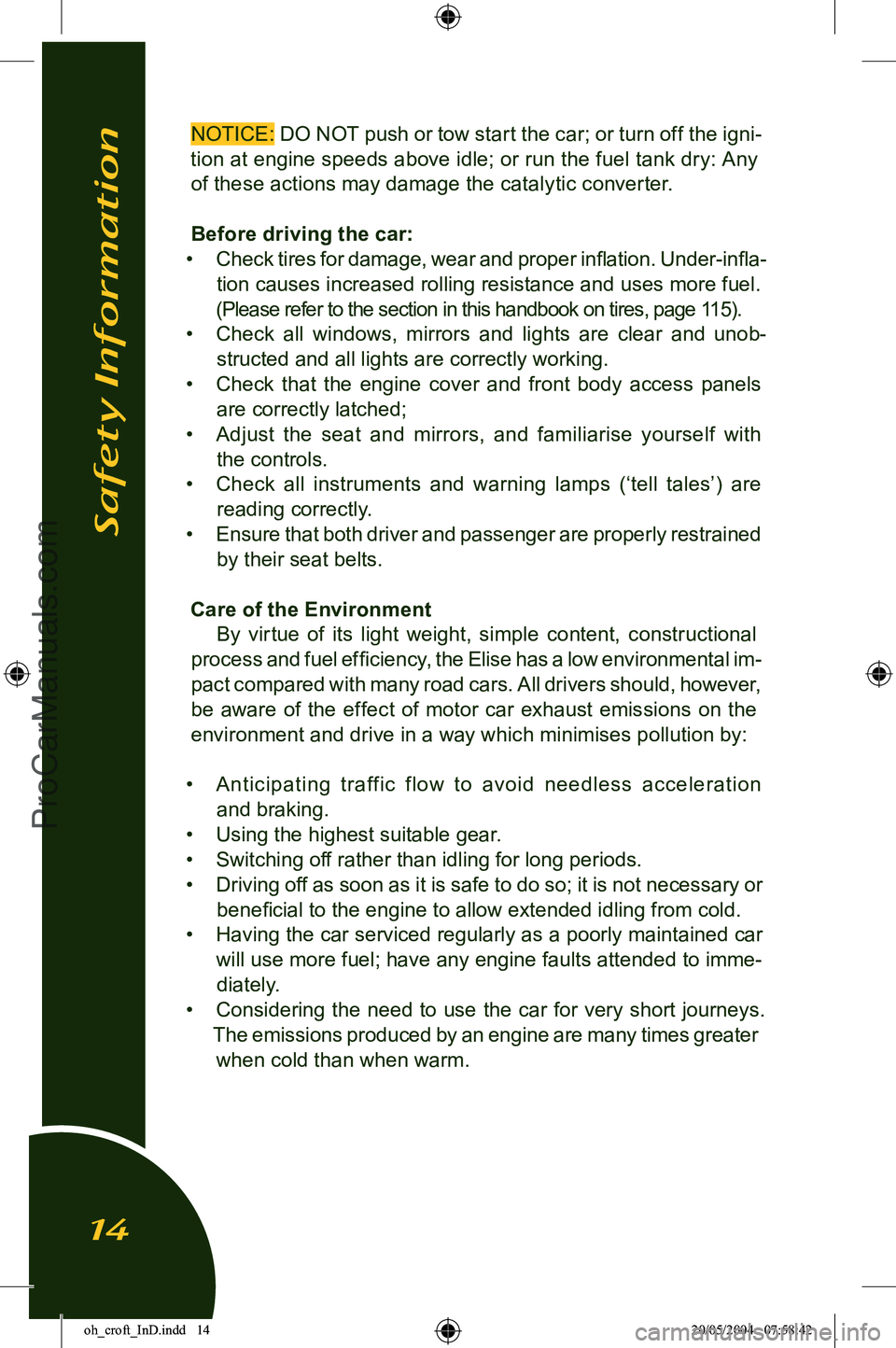
NOTICE: DO NOT push or tow start the car; or turn off the igni-
tion at engine speeds above idle; or run the fuel tank dry: Any of these actions may damage the catalytic converter.
Before driving the car:
ā¢ Check tires for damage, wear and proper inļ¬ation.
Under-inļ¬a-
tion causes increased rolling resistance and uses more fuel.
(Please refer to the section in this handbook on tires, page 115).
ā¢ Check all windows, mirrors and lights are clear and unob
-
structed and all lights are correctly working.
ā¢ Check that the engine cover and front body access panels
are correctly latched;
ā¢ Adjust the seat and mirrors, and familiarise yourself with
the controls.
ā¢ Check all instruments and warning lamps (ātell talesā) are reading correctly.
ā¢ Ensure that both driver and passenger are properly restrained
by their seat belts.
Care of the Environment By virtue of its light weight, simple content, constructional
process and fuel efļ¬ciency, the Elise has a low environmental im
-
pact compared with many road cars. All drivers should, however,
be aware of the effect of motor car exhaust emissions on the
environment and drive in a way which minimises pollution by:
ā¢ Anticipating traffic flow to avoid needless acceleration
and braking.
ā¢ Using the highest suitable gear.
ā¢ Switching off rather than idling for long periods.
ā¢ Driving off as soon as it is safe to do so; it is not necessary or beneļ¬cial to the engine to allow extended idling from cold.
ā¢ Having the car serviced regularly as a poorly maintained car will use more fuel; have any engine faults attended to imme
-
diately.
ā¢ Considering the need to use the car for very short journeys.
The emissions produced by an engine are many times greater
when cold than when warm.
Safety Information
14
oh_croft_InD.indd 1420/05/2004 07:58:42ProCarManuals.com
Page 17 of 205
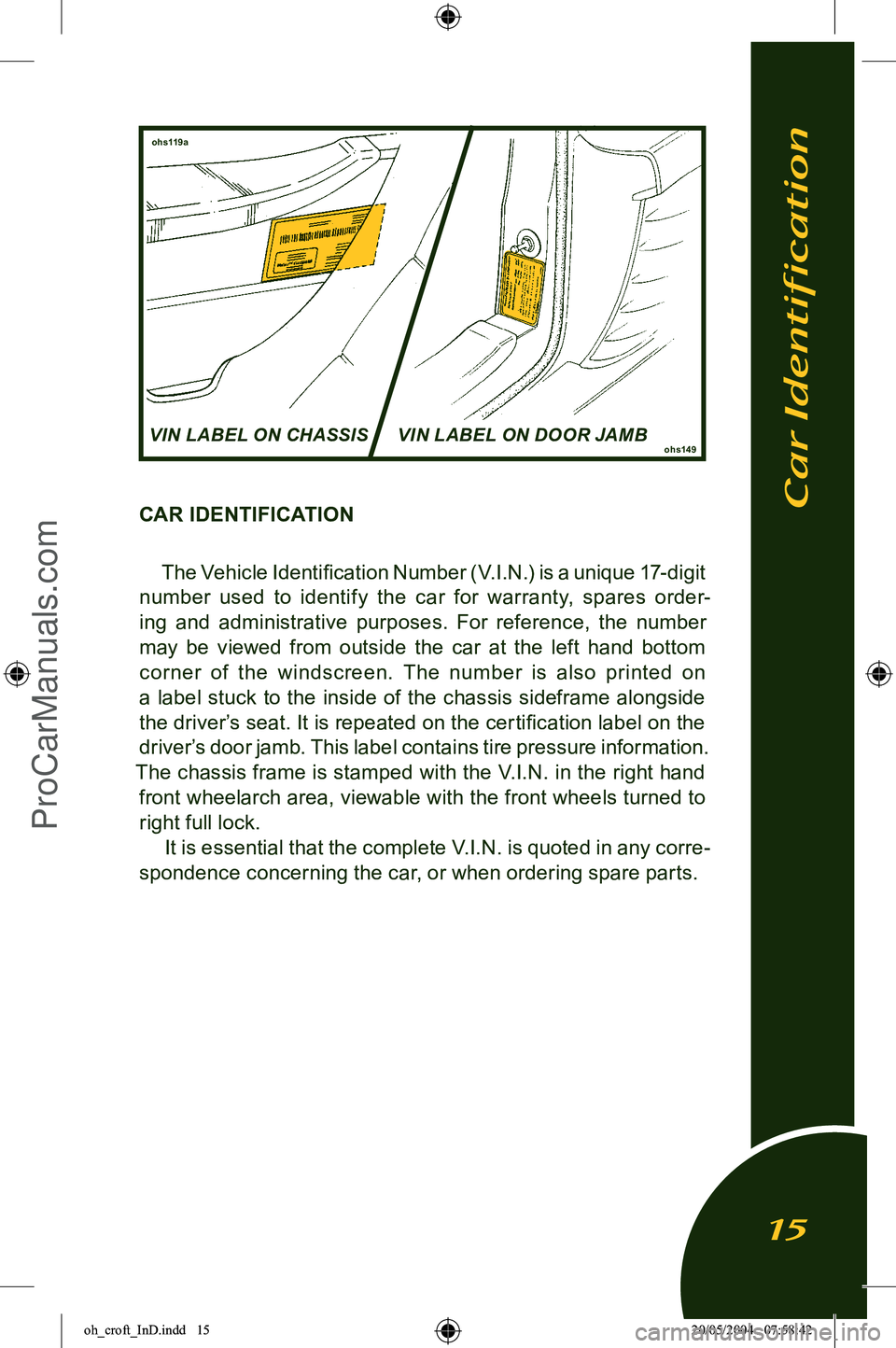
CAR IDENTIFICATIONThe Vehicle Identiļ¬cation Number (V.I.N.) is a unique 17-digit
number used to identify the car for warranty, spares order
-
ing and administrative purposes. For reference, the number may be viewed from outside the car at the left hand bottom
corner of the windscreen. The number is also printed on
a label stuck to the inside of the chassis sideframe alongside
the driverās seat. It is repeated on the certiļ¬cation label on the
driverās door jamb. This label contains tire pressure information.
The chassis frame is stamped with the V.I.N. in the right hand front wheelarch area, viewable with the front wheels turned to right full lock.
It is essential that the complete V.I.N. is quoted in any corre
-
spondence concerning the car, or when ordering spare parts.
VIN LABEL ON DOOR JAMB VIN LABEL ON CHASSIS
Car Identification
15
ohs119a
ohs149
oh_croft_InD.indd 1520/05/2004 07:58:42ProCarManuals.com
Page 19 of 205

SEATING & SAFETY RESTRAINTS
SeatsOn delivery of the car, ļ¬rst remove the protective plastic
seat covers, if this has not already been done, and dispose of
safely. To adjust the fore/aft position of the driverās seat, raise the
lift bar beneath the front of the seat, and slide to the position
required. Ensure that the catch is fully engaged after adjustment
by attempting to slide the seat without touching the lift bar. Note
that the passenger seat position is ļ¬xed and cannot be adjusted, and that the backrest angle of both seats is ļ¬xed, and cannot be reclined.
WARNING:
ā¢ Sit as far back from the steering wheel as is comfortable, whilst ensuring that full control can be maintained. Sit
-
ting too close to an airbag can result in serious injury or death if the airbag inļ¬ates.
ā¢ Ensure that your chest is at least 10 inches (250mm) from
the steering wheel.
ā¢ Do not attempt to adjust the seat position whilst driving as this could adversely affect your control of the car.
ā¢ Ensure that no persons or objects will be trapped when adjusting the seat.
Lumbar Support (if ļ¬tted): On seats equipped with adjustable
lumbar support, an inļ¬ator ābulbā (A) and air release button (B)
ohs64a
SEAT ADJUSTMENTS
Seating & Safety Restraints
17
oh_croft_InD.indd 1720/05/2004 07:58:43ProCarManuals.com
Page 20 of 205
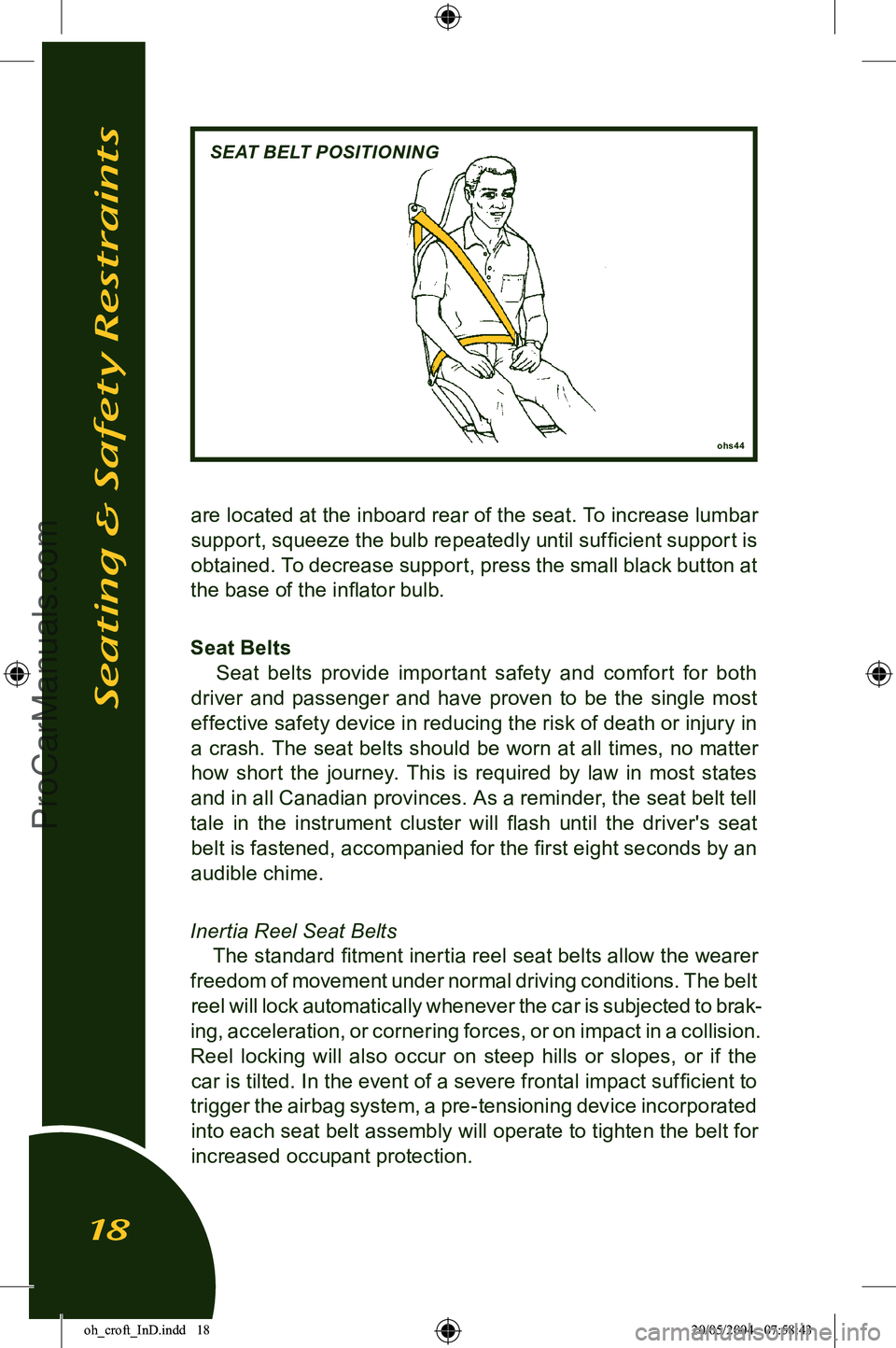
are located at the inboard rear of the seat. To increase lumbar
support, squeeze the bulb repeatedly until sufļ¬cient support is obtained. To decrease support, press the small black button at
the base of the inļ¬ator bulb.
Seat Belts Seat belts provide important safety and comfort for both
driver and passenger and have proven to be the single most
effective safety device in reducing the risk of death or injury in
a crash. The seat belts should be worn at all times, no matter how short the journey. This is required by law in most states
and in all Canadian provinces. As a reminder, the seat belt tell
tale in the instrument cluster will ļ¬ash until the driver's seat
belt is fastened, accompanied for the ļ¬rst eight seconds by an
audible chime.
Inertia Reel Seat Belts The standard ļ¬tment inertia reel seat belts allow the wearer
freedom of movement under normal driving conditions. The belt reel will lock automatically whenever the car is subjected to brak
-
ing, acceleration, or cornering forces, or on impact in a collision. Reel locking will also occur on steep hills or slopes, or if the
car is tilted. In the event of a severe frontal impact sufļ¬cient to
trigger the airbag system, a pre-tensioning device incorporated into each seat belt assembly will operate to tighten the belt for
increased occupant protection.
ohs44
SEAT BELT POSITIONING
Seating & Safety Restraints
18
oh_croft_InD.indd 1820/05/2004 07:58:43ProCarManuals.com